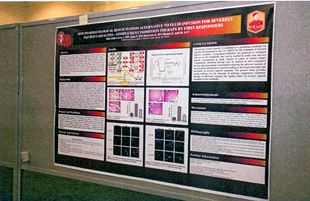The Division of Military Casualty Research at Walter Reed Army Institute of Research won the 2010 Society of Armed Forces Medical Laboratory Scientists Best Research Poster

Maj. Jurandir DalleLucca, Spc. Parag Apte, Sgt. 1st Class Carlis Moses, and Spc. Catherine Stracener of the Walter Reed Army Institute of Research Division of Military Casualty Research were winners of the 2010 Society of Armed Forces Medical Laboratory Scientists Best Research Poster.
The poster contest took place March 21-26 in San Diego, Calif.
Hemorrhagic shock is the leading cause of death among military casualties. It accounted for 45-68% of U.S. military deaths in Operation Iraqi Freedom and most of the deaths occurred prior to hospital arrival.
The group worked on a controlled hemorrhagic shock model with different complement inhibitors like decay accelerating factor and C1-Inhibitor. During the entire period, the blood chemistry is analyzed. Afterwards the different tissues are collected, for immune-histo-chemistry and histological analysis.
Once bleeding is controlled to the extent possible, life is sustained on the battlefield and in transit to surgical care units through the use of resuscitation fluids. Military surgeons have found that traditional approaches to resuscitation often fail to effectively treat the coagulopathy that is invariably present on arrival in these soldiers.
Strategies aimed at reducing or eliminating the need for resuscitation fluid have been identified as a major requirement for military medicine. The results of this protocol research identify C1-Inhibitor as a promising candidate for advance development by the U.S. Army for the treatment of severely injured casualties.
Complement inhibitors are practical to transport and use on the battlefield. They can be carried in small vials and are quickly reconstituted in small volumes of saline or lactate ringer. Complement inhibition therapy can be used by first responders during pharmacological resuscitation reducing the adverse the adverse reaction of inflammatory response leading to decreased mortality and morbidity of severely injured casualties.
The present study provides strong evidence for the rationale of using complement inhibition therapy to effectively increase the "golden hour" of severely injured casualties on the battlefield.














